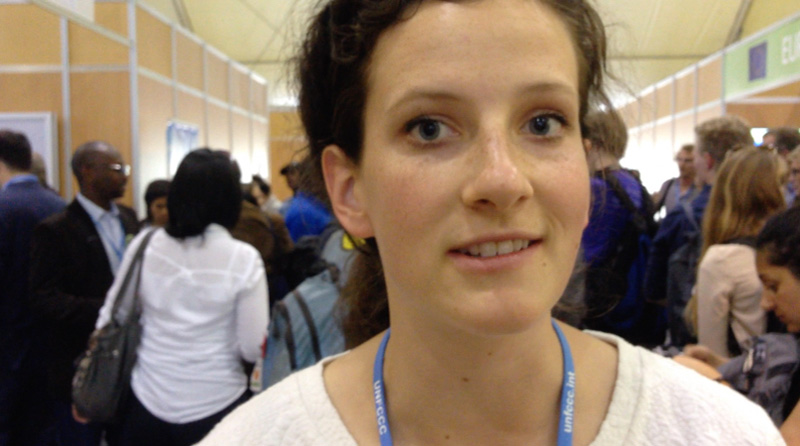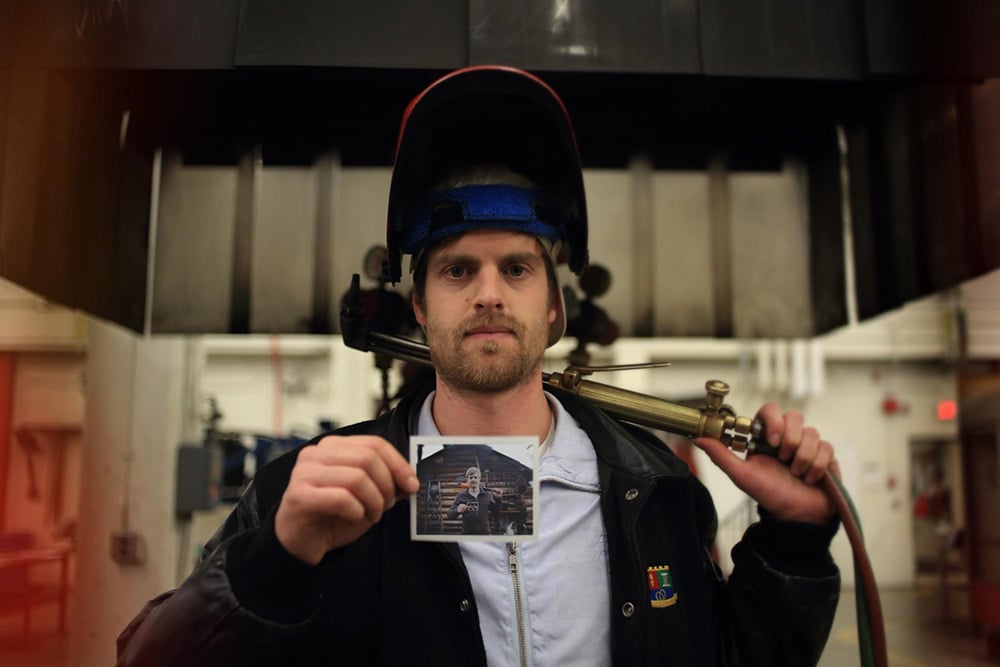What will a transition away from oil and gas mean for workers in Alberta?
Perhaps greater job security than in the boom and bust heydays of the oilsands, comparable wages and less time apart from family.
This is not a utopian pipe dream. Over the past month The Tyee spoke with experts across the province and the country who said Albertans have the skills and desire to build the sustainable energy system necessary to address our climate emergency.
“A lot of the people that support the pipeline are also very pro-renewable energy,” said Lliam Hildebrand, who spent years working in the oilsands and now runs a group called Iron & Earth that advocates for policies connecting oil workers to the millions of jobs required to build a low-carbon economy in Canada.
Decades of employment for laid-off Albertans could be unlocked by our political leaders in a matter of days.
Calgary roofer and Alberta Liabilities Disclosure Project researcher Regan Boychuk says tens of thousands of oil workers could be hired to clean up polluted oil and gas wells.
“It could be implemented in a weekend,” he added.
“Humans are somewhat predisposed to wanting to avoid change,” said Alison Cretney, managing director of the Alberta-based Energy Futures Lab, which works on plans for the province’s transition from fossil fuels.
But she says business leaders who embrace the future instead of resisting it could find great opportunities. They could build companies that extract lithium for electric car batteries from oil wastewater, or use Alberta’s vast fossil fuel reserves to create a hydrogen economy many times more lucrative than selling oil and natural gas at a discount to the U.S.
Decision-makers who harness the massive economic changes happening all around us could start healing the severe damage that oil and gas extraction has inflicted on Alberta’s natural environment and help repair Canada’s relationship with the Indigenous people who’ve lived there for at least 11,000 years.

Bronwen Tucker, an Edmonton-based researcher for the advocacy group Oil Change International said people don’t yet grasp the opportunities that are available.
“We’ve never told another story of what’s possible in Alberta,” said Tucker, “[We’ve] never been allowed to.”
‘It was terrifying’
Iron & Earth’s Lliam Hildebrand worked at the Long Lake oilsands project in 2015 when plummeting oil prices caused companies across the industry to fire tens of thousands of people.
“It was terrifying,” he said. He started talking to others about a Plan B. “What we found out was that in a lot of countries renewable energy was actually the fast-growing job provider and that a lot of those jobs were very relevant to our skill set,” he said.
Hildebrand has worked in a steel-fabricating shop that built things like pressure vessels, flare stacks and drilling rig platforms for the oilsands. The shop also took on contracts to build an industrial heat-generating composter, a biomass plant and a wind farm weather station.
“I was able to build all these different renewable energy technologies without retraining,” he said. “It was the same process of steel coming through, I’d read the blueprint, cut the steel up, put it into place and have the welders weld it.”
Nearly two-thirds of energy sector workers surveyed by Iron & Earth in 2016 said their skills could be directly applied to renewable energy work with additional training and about 15 per cent said they could make the shift without it.
Training could mean something as simple as a five to 10-day intensive “upskilling” course. But Hildebrand notes that many workers aren’t eligible for training subsidies covering these types of courses until they’ve secured actual employment in renewable energy.
“But that’s backwards,” he says.
He argues we should be providing the skills training first, so that workers have a way of earning money during periods when oilsands work dries up. They could then switch back and forth between fossil fuels and renewables depending on where the most work is. That would provide some stability and help build a more sustainable system. Those workers are less exposed to mass layoffs caused by oilsands downturns while at the same time helping to build a more sustainable system.
Hildebrand says it’s about “diversifying our work opportunities.”
And leaving fossil fuels doesn’t necessarily mean a pay cut. “Some of the larger projects like wind farms and utility-scale solar pay actually fairly comparable to other energy industries,” he said.
Turning liabilities into jobs
The transition away from oil would also make Alberta healthier. Across the province there are about 450,000 oil and gas wells, at least 155,000 of which aren’t producing, but haven’t been reclaimed and cleaned up. Some people living close to them say they have experienced severe headaches and chronic health problems.
The government says that the total cost of cleaning up Alberta’s oil and gas industry is about $58 billion.
But earlier this year, the Alberta Liabilities Disclosure Project released a report estimating the cost of cleaning up abandoned oil wells alone at $40 to $70 billion. Private regulatory documents obtained by Boychuk suggest when you add in aging pipelines and things like toxic tailings ponds, the cleanup cost could exceed $260 billion.
That’s a looming financial and ecological catastrophe for the province, given that it’s collected less than $2 billion from companies to cover cleanup costs.
But Boychuk says with the right policies, cleaning up after the industry could be “a quarter trillion economic opportunity.”
For years he’s been fine-tuning a plan that would see tens of thousands of people — including those still struggling from the oil downturn — put to work reclaiming polluted oil wells. Many could start immediately.
“In the service sector all the truck drivers, all the different services involved in drilling and servicing a rig, are the same ones involved in the cleanup,” he said.
Boychuk proposes that when an oil and gas company goes bankrupt — like Calgary’s Trident Exploration, which folded in May and walked away from 3,358 operating wells — a government-supported reclamation trust could step in and operate the wells.
“You don’t have to pay executives anymore, you don’t have to pay investors,” he said. “What oil and gas is left behind from these failed companies just became a lot more profitable.”
The revenue would then be used to pay cleanup workers. Because wells are spread over every corner of the province, it’s conceivable people can work close to homes and families. Boychuk claims it would potentially create decades of employment.
“We’ve been offering this plan to the government in Alberta for years,” he said. “But there’s a lack of political will.”
‘Everybody’s replaceable’
The political leaders in favour of new pipelines and oilsands expansion tend to put forward a simplified view: things that create jobs are good. But we seldom debate the quality of those jobs, the tolls they take on families or the unjust power relations that can be built into them.
Over the past several years Angele Alook has been interviewing working-class Indigenous people in the town of Wabasca in northern Alberta to learn about the social impacts of oilsands employment.
“The industry works 24-7, so people are working very long shifts, they work 12- to 13-hour days,” she said. They can be away from partners and children for weeks or months. “That really creates an imbalance in families,” she said.
Alook is a member of the Bigstone Cree Nation. She worked as a researcher with the Alberta Union of Provincial Employees and recently became an assistant professor in the School of Gender, Sexuality and Women’s Studies at York University.
Some people she spoke with struggled with feelings their employment was precarious. “Everybody’s replaceable, right?” one worker told her.
Indigenous workers said they were often passed over for wage increases and promotions in white-owned companies and were stuck in lower-skilled positions. Research suggests that during resource downturns, they are often the first to be laid off.
“Indigenous people don’t reap the benefits of this industry,” Alook said.
The shift away from oil could create opportunities for better-paying and more meaningful work. The billions of dollars that Canada spends subsidizing the oil and gas industry could partly be redirected to education for Indigenous peoples, she said. “The federal funding that we get for post-secondary does not meet the demand that we have,” she said.
Canada could accelerate the healing of our natural environment by fully implementing the United Nations Declaration on the Rights of Indigenous Peoples.
“There’s specific articles that... talk about our right to our sovereignty and decisions regarding our land,” she said. “If the land is healthy and prosperous, then we are.”
A just transition for workers
There’s no denying economic transitions can be painful. Canadian Labour Congress president Hassan Yussuff was reminded of this as he travelled the country meeting people affected by the federal government’s decision to shut down coal-fired power generation by 2030. “There was a lot of worries about what was going to happen,” he said.
Yussuff did this work as co-chair of a federal government task force on “Just Transition for Canadian Coal Power Workers and Communities.”
The group, set up on the urging of Canada’s labour movement, looked at the social impacts of shifting away from coal, a fossil fuel that helped build the country’s economy, and give advice on how to make those impacts less severe.
“When the Government of Canada says it is going to ‘phase out coal,’ coal workers and communities hear that Canada is phasing out their future, livelihood, stability and identity,” the task force wrote in a report this spring.
But the signs of coal’s global decline are clear. And the guiding logic behind the task force’s work was that it’s better to meet with workers and ease them into whatever comes next rather than waiting for the market to collapse and forcing them to fend for themselves.
“The concept of just transition is not idealistic,” Yussuff explained. It’s a concrete strategy for ensuring as few people as possible suffer during our shift to a more sustainable economy, he added. The task force produced 10 recommendations, including setting up “locally-driven transition centres,” pension supports for workers who have to retire early and job-creating infrastructure projects.
The feds have so far committed $35 million to this effort. Yet the task force thinks the final “costs of the phase-out will stretch well into the hundreds of millions of dollars.”
Yussuff suggested the investment is well worth it, not only for coal workers and their families, but as a proof of concept for shifting our entire economy off climate-destroying activities.
“If you can get some of this right, hopefully we might be able navigate some bigger challenges that we have to deal with in this country,” he said.
‘It’s within reach’
One common misconception about building a low-carbon economy is that we have to start from scratch. The Energy Futures Lab challenges that logic by supporting research into new business opportunities that grow out of old ones. “There’s tweaking and adjustments that need to happen,” Cretney said. “But we’re not talking about a complete remake of everything.”
The Lab’s work is supported by several dozen fellows who span a wide range of industries and backgrounds. Its supporters include oilsands companies (Suncor), public sector organizations (Alberta Innovates), renewables groups (Indigenous Clean Energy) and environmental watchdogs (the Pembina Institute).
Cretney says one way we get to a low- or zero-carbon economy in Alberta is by using bitumen to build things rather than burning it in vehicle engines. The resource could potentially be used in carbon fibre, fortified steel, asphalt or even as a source of vanadium for renewable energy storage batteries.
There is also huge potential to produce zero-emission fuel from the province’s oil and gas reserves, argue University of Calgary professor David Layzell and hydrogen researcher Jessica Lof.
“Our research shows that Alberta’s best ‘Plan B’ for the future of its oil-based economy is to transition to the production of a clean, more energy efficient, and much more valuable transportation fuel: hydrogen,” they write.
Alberta oil currently sells for the equivalent of $4 to $8 per gigajoule of energy. They calculate that hydrogen fuel could fetch prices of $18 to $25. “[It] would generate two to four times more economic activity for Alberta than producing and exporting crude oil for the diesel market,” Layzell and Lof write.
All these solutions require foresight and creativity from our political leaders. But those are the same qualities that allowed Alberta to build an oil industry in the first place. Now it’s time to create an economy that helps solve the climate crisis, gives people stable and meaningful jobs and is every bit as prosperous — if not more so —than what came before it.
“It’s about developing these industries of the future not in spite of, but really because of, the oil and gas industry today,” Cretney said. “Because of that it’s within reach.” ![]()
Read more: Energy, Politics, Labour + Industry, Environment

















Tyee Commenting Guidelines
Comments that violate guidelines risk being deleted, and violations may result in a temporary or permanent user ban. Maintain the spirit of good conversation to stay in the discussion.
*Please note The Tyee is not a forum for spreading misinformation about COVID-19, denying its existence or minimizing its risk to public health.
Do:
Do not: